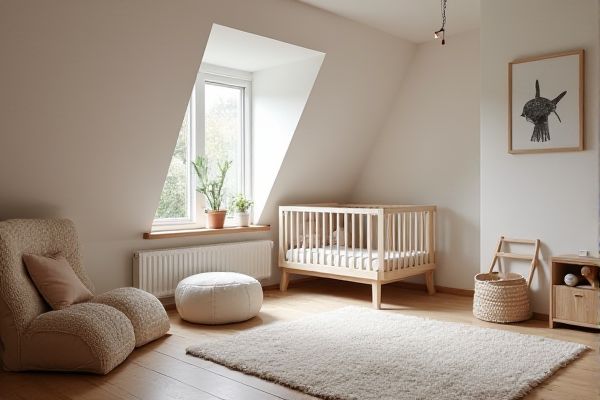
Choosing between an attic nursery and an attic playroom depends on your child's current needs and safety considerations, as nurseries require a controlled and serene environment while playrooms can accommodate more active, playful activities. Explore the advantages and design tips for each option in the rest of the article to help you create the perfect space for your family.
Table of Comparison
| Feature | Attic Nursery | Attic Playroom |
|---|---|---|
| Purpose | Safe sleeping and care space for infants | Engaging play area for toddlers and children |
| Design Focus | Comfort, safety, and soothing environment | Fun, creativity, and active play |
| Furniture | Crib, changing table, rocking chair | Storage shelves, play mats, child-sized furniture |
| Safety Features | Baby-proof locks, soft flooring, secured windows | Soft edges, non-slip mats, hazard-free zones |
| Lighting | Soft, dimmable lighting for naps and sleep | Bright, natural or artificial light for activities |
| Space Usage | Quiet and cozy area optimized for rest | Open and flexible space for active play |
| Storage | Diaper and baby care essentials | Toys, books, and games |
| Age Group | Newborn to 1 year old | 1 year and older |
Attic Nursery vs Attic Playroom: Key Differences
An attic nursery is designed specifically for infant care, featuring safety elements like temperature control, soft flooring, and storage for baby essentials, while an attic playroom caters to older children with open space for toys, games, and creative activities. Lighting and insulation in a nursery prioritize warmth and comfort for babies, whereas a playroom emphasizes durability and versatility for active play. Soundproofing and easy accessibility are crucial in both, but nurseries demand quieter environments to support sleep and feeding schedules.
Benefits of Converting an Attic into a Nursery
Converting an attic into a nursery maximizes unused space while providing a quiet, cozy environment ideal for infants. The elevated location ensures privacy and separation from the main living areas, reducing noise and distractions. Proper insulation and ventilation in attic nurseries promote a comfortable climate, essential for a baby's health and safety.
The Advantages of an Attic Playroom
An attic playroom offers a dedicated space designed for children's activities, promoting creativity and physical play without disrupting other areas of the home. Unlike an attic nursery, which primarily serves as a sleeping area for infants, an attic playroom accommodates a wider age range with versatile layout options and safety features tailored to active use. Maximizing available square footage in the attic enhances home functionality and encourages family interaction in a bright, stimulating environment.
Safety Considerations for Attic Spaces
Attic nurseries require stringent safety measures including proper insulation, secure railings, and reliable ventilation to maintain a healthy environment for infants. Attic playrooms also demand childproofing features such as padded flooring, safe electrical outlets, and adequate lighting to prevent accidents during play. Both spaces benefit from fire alarms and emergency exits to ensure overall safety in the attic environment.
Space Planning: Nursery vs Playroom Layouts
Attic nursery layouts prioritize safety and accessibility with compact, organized zones for sleeping, changing, and storage, ensuring ample natural light and ventilation. Attic playroom designs focus on open, flexible spaces that accommodate various activities, incorporating soft flooring, storage for toys, and creative areas for play and learning. Effective space planning for both involves maximizing limited attic square footage while addressing specific functional needs of infants versus active children.
Design Ideas for a Cozy Attic Nursery
Transforming an attic into a cozy nursery involves utilizing soft pastel tones, low-level lighting, and plush textiles to create a warm and inviting atmosphere. Incorporate built-in storage solutions under sloped ceilings to maximize space and maintain an uncluttered environment ideal for baby essentials. Consider adding a comfortable rocking chair and blackout curtains to enhance functionality and comfort within the compact attic nursery.
Creative Themes for an Attic Playroom
Attic playrooms offer a unique canvas for creative themes, from whimsical woodland adventures with treehouse-style decor to vibrant space explorations featuring glow-in-the-dark stars and planets. Designing an attic playroom allows for incorporating playful elements like chalkboard walls, climbing ropes, and cozy reading nooks, maximizing the sloped ceiling and natural light. These imaginative spaces foster creativity and active play, distinguishing them from the calmer, more restful atmosphere typically found in attic nurseries.
Storage Solutions for Attic Nurseries and Playrooms
Attic nurseries benefit from compact storage solutions like wall-mounted shelves and under-crib drawers to maximize limited space while keeping essentials organized and accessible. In contrast, attic playrooms require larger storage options such as modular toy bins and built-in cabinets to accommodate a variety of toys and games, helping maintain a clutter-free area for play. You can enhance both spaces by utilizing vertical storage and multifunctional furniture tailored to the unique dimensions of attic rooms.
Cost Comparison: Nursery vs Playroom Conversion
Converting an attic into a nursery typically involves higher costs due to the need for specialized amenities like soundproofing, climate control, and safety features to accommodate infants. An attic playroom conversion tends to be more cost-effective, requiring fewer structural modifications and simpler finishes, as it mainly serves as a recreational space for older children. Budget estimates for nursery conversions can range from $10,000 to $25,000, while playroom conversions commonly cost between $5,000 and $15,000, depending on insulation, flooring, and electrical upgrades.
Making the Best Choice for Your Family’s Needs
Choosing between an attic nursery and an attic playroom depends on your family's current priorities and future plans. An attic nursery offers a cozy, quiet space designed for restful sleep and early development, while an attic playroom provides a lively area encouraging creativity and physical activity. Assess your child's age, space requirements, and lifestyle to make the best choice for your family's unique needs.
 homyna.com
homyna.com